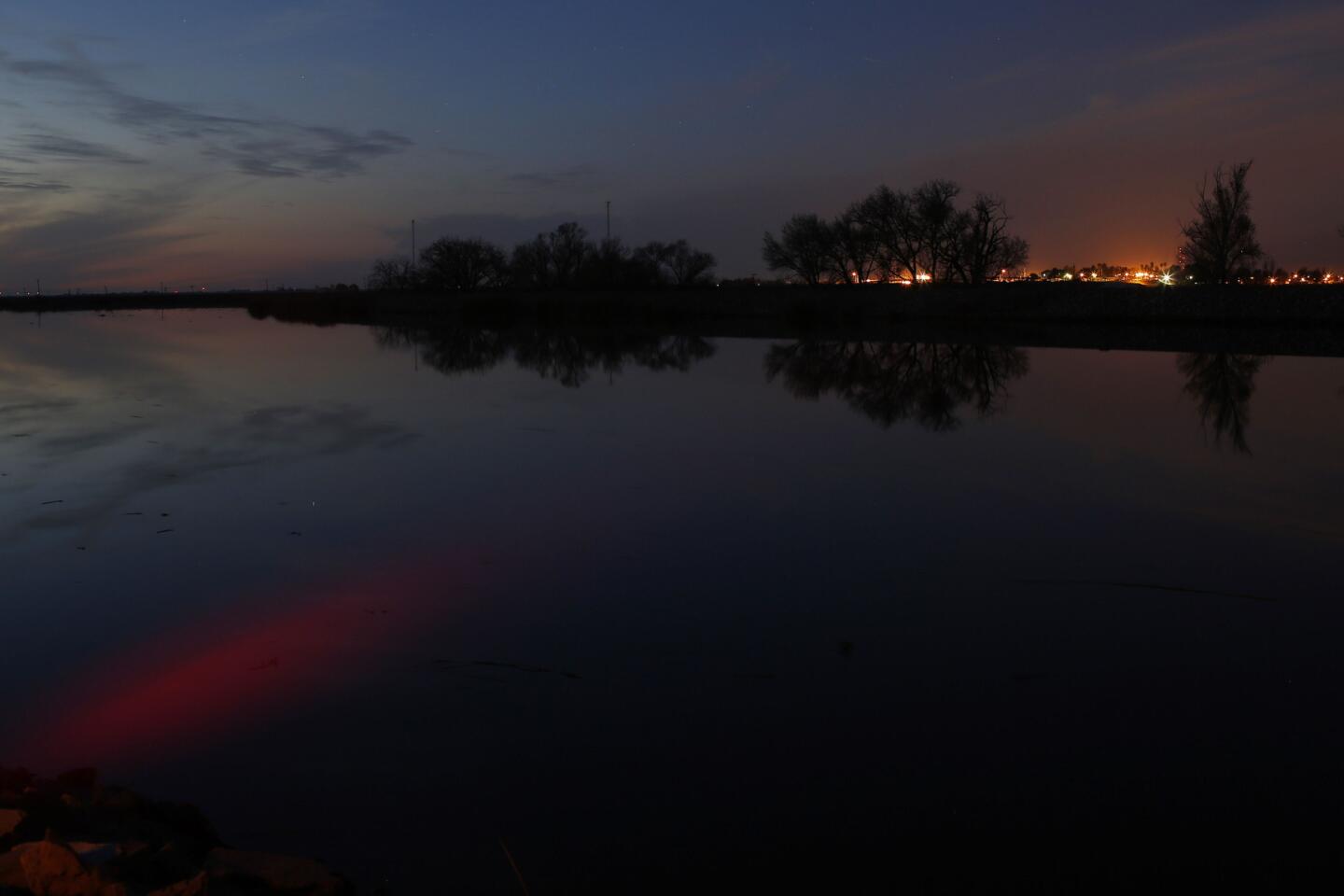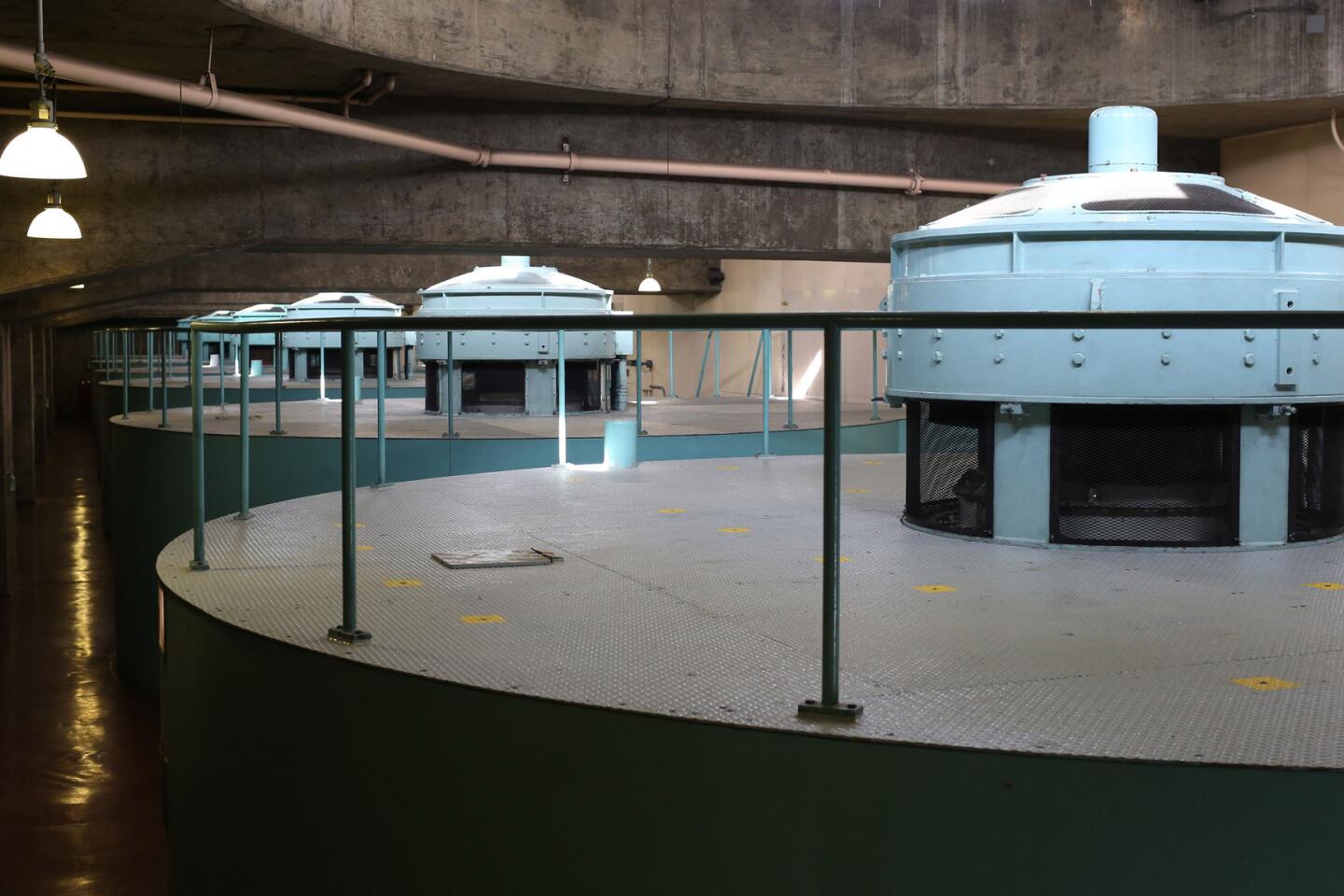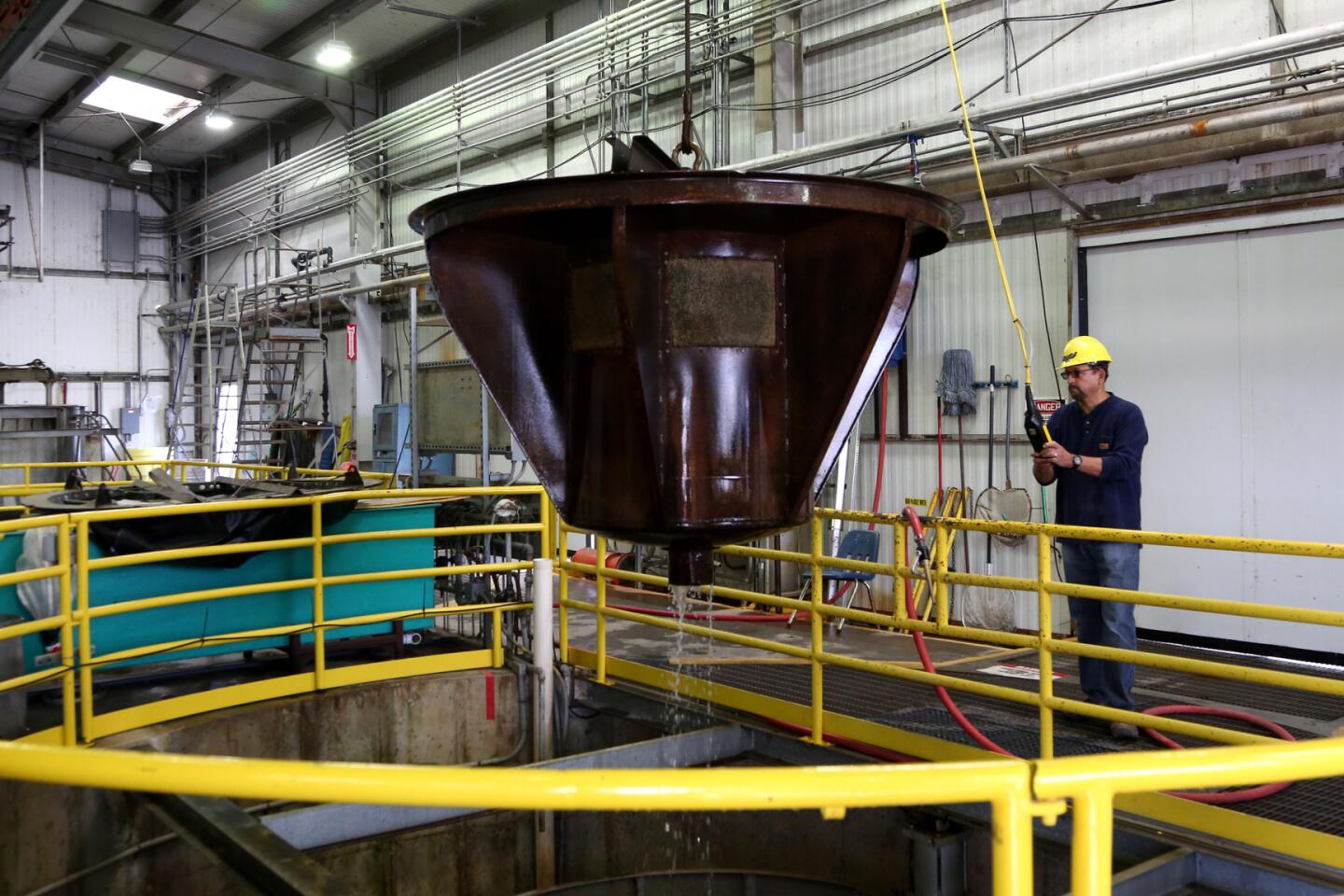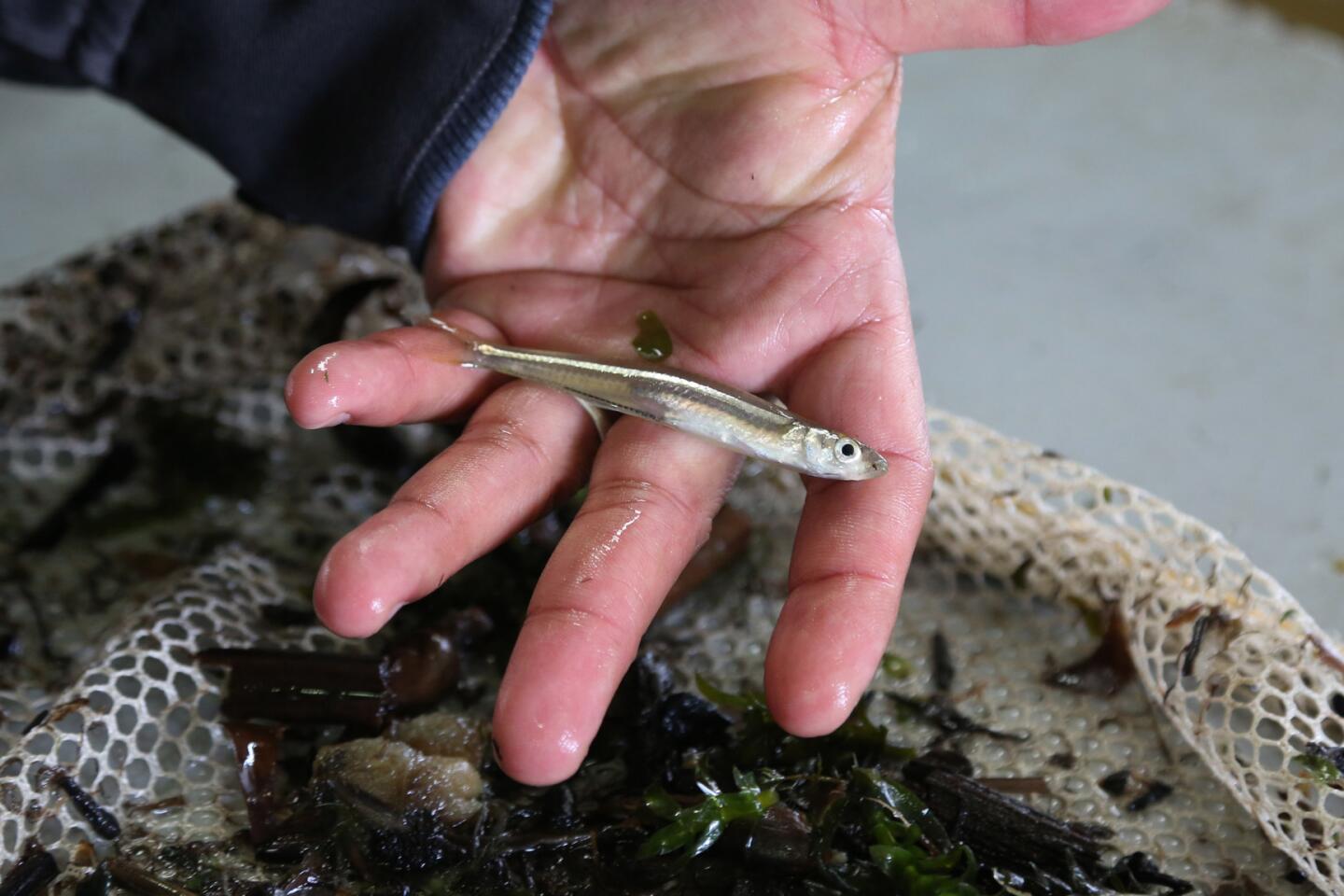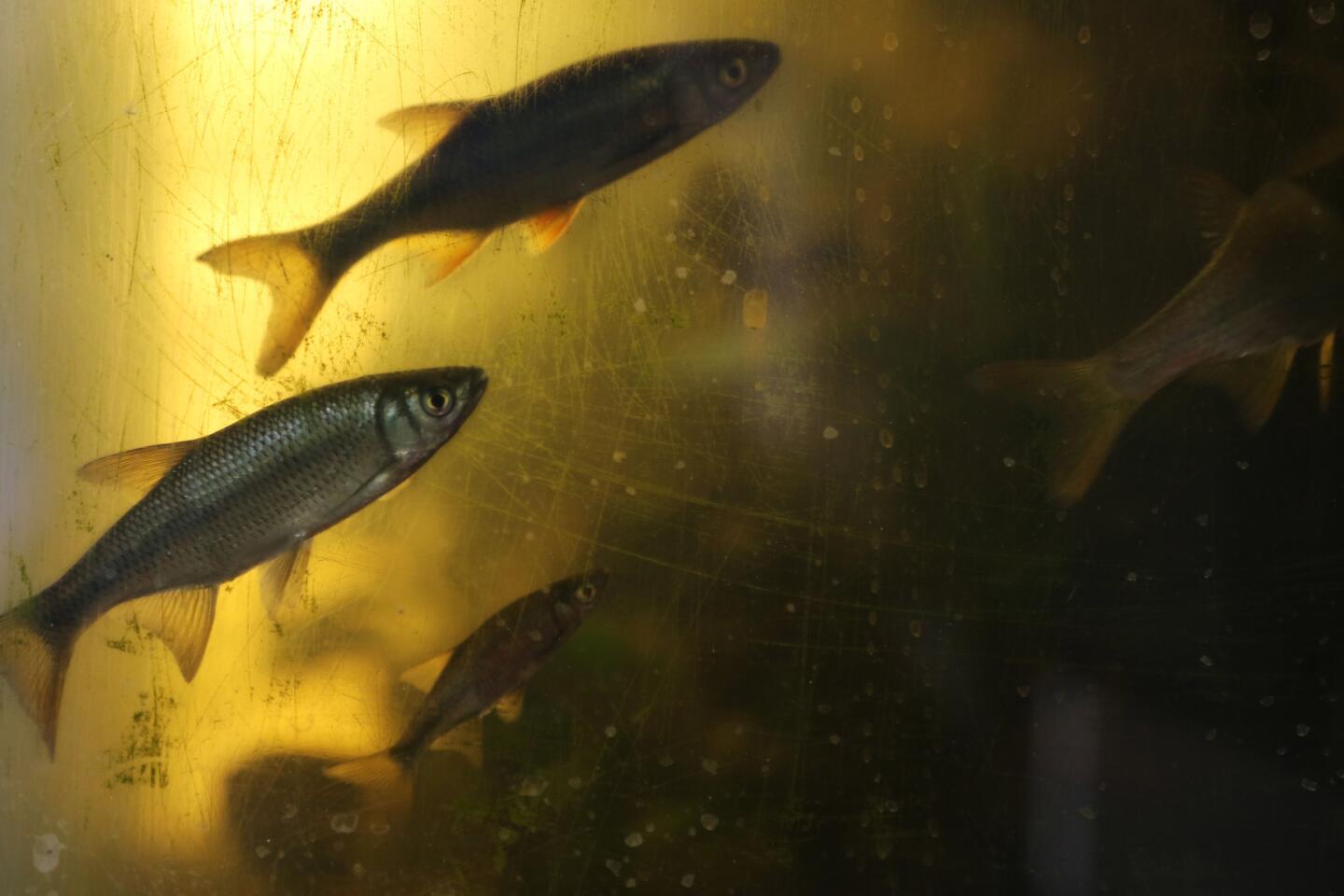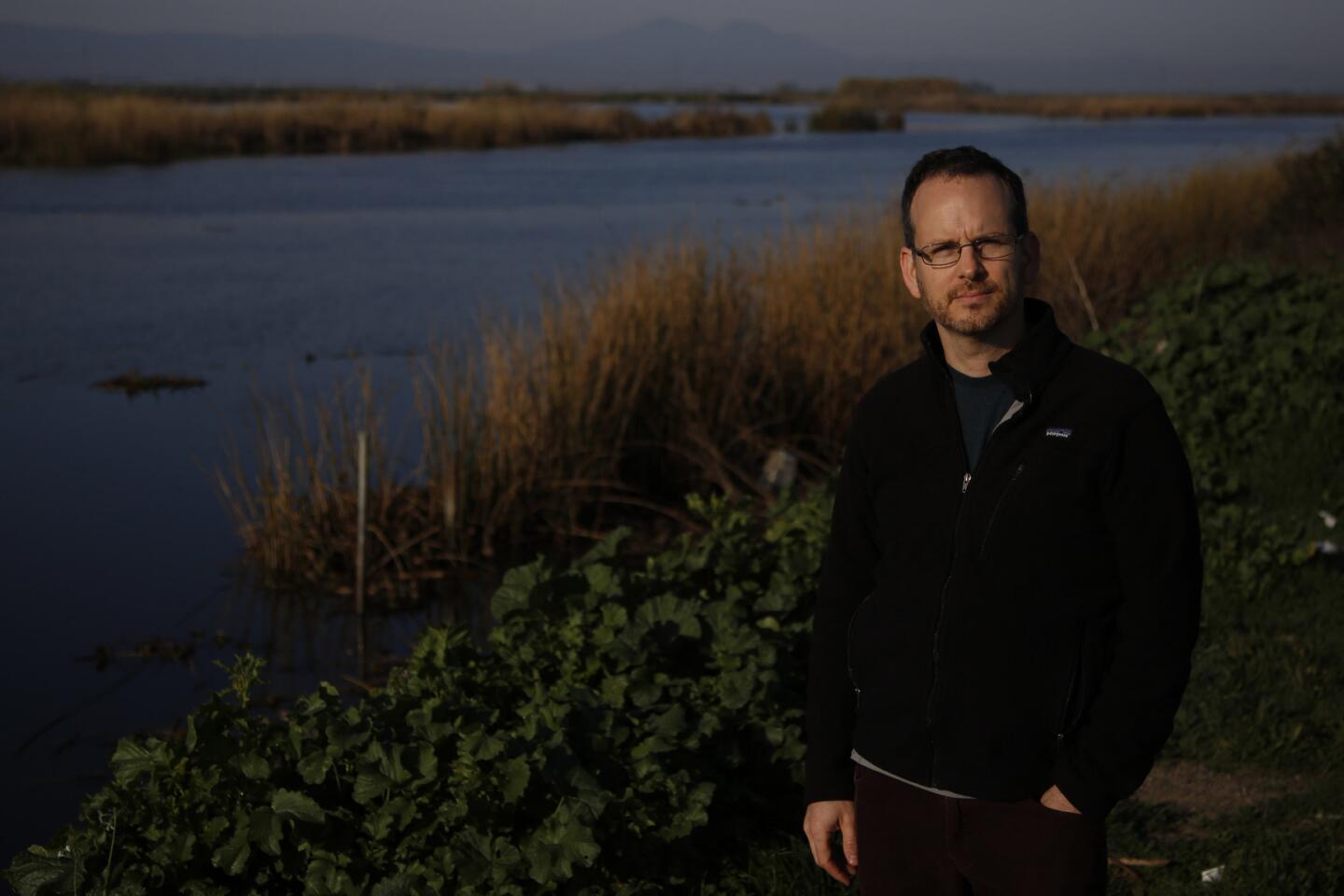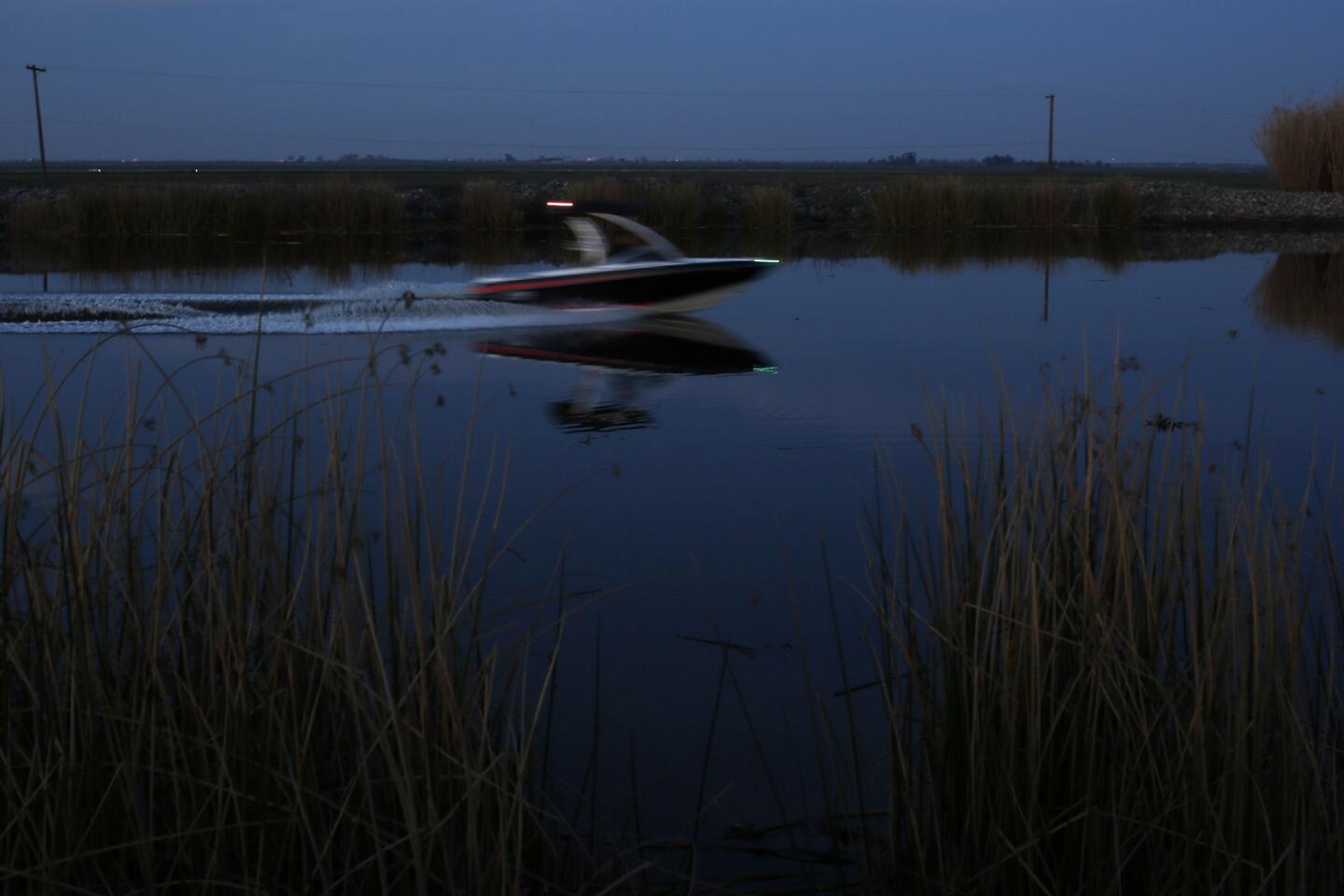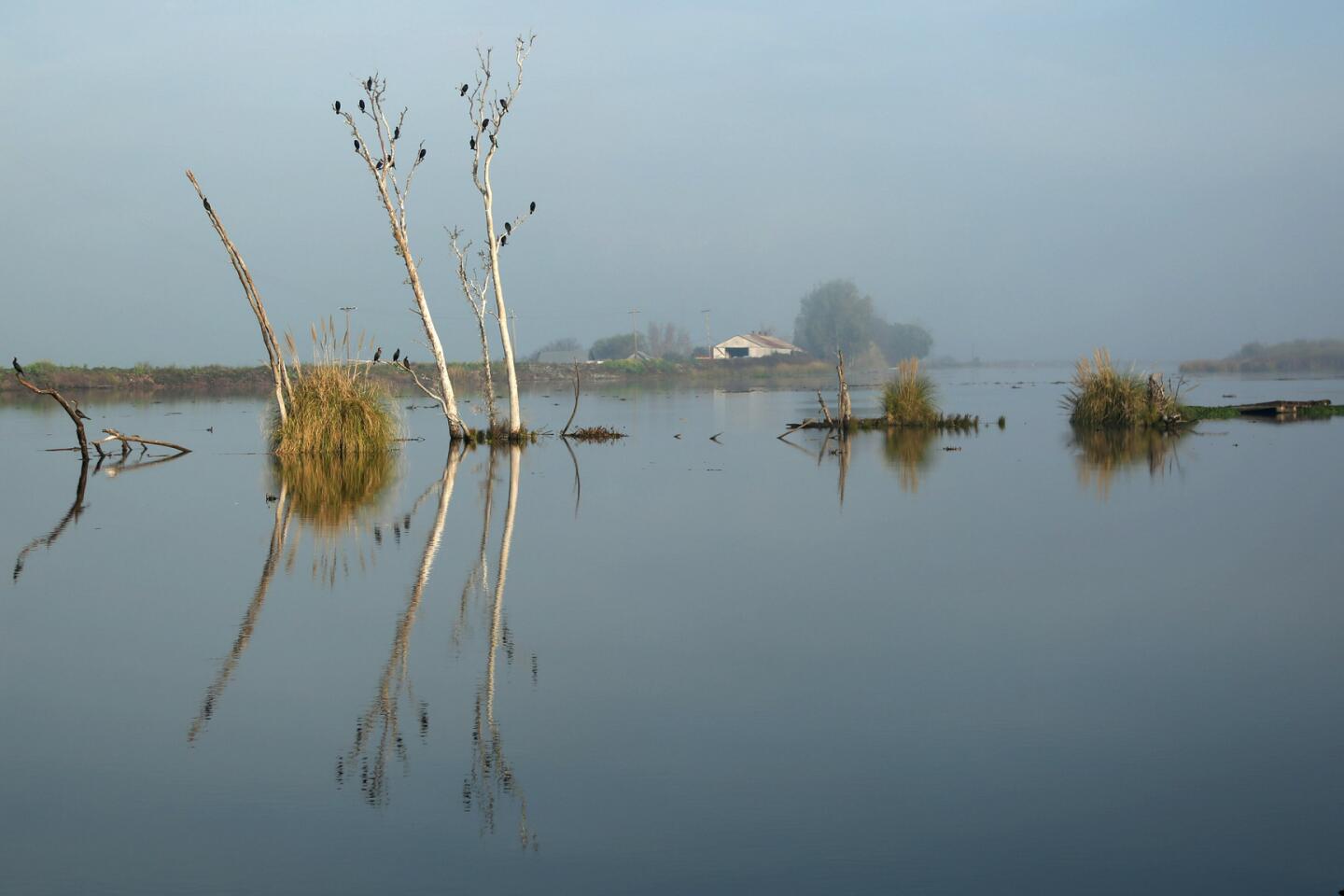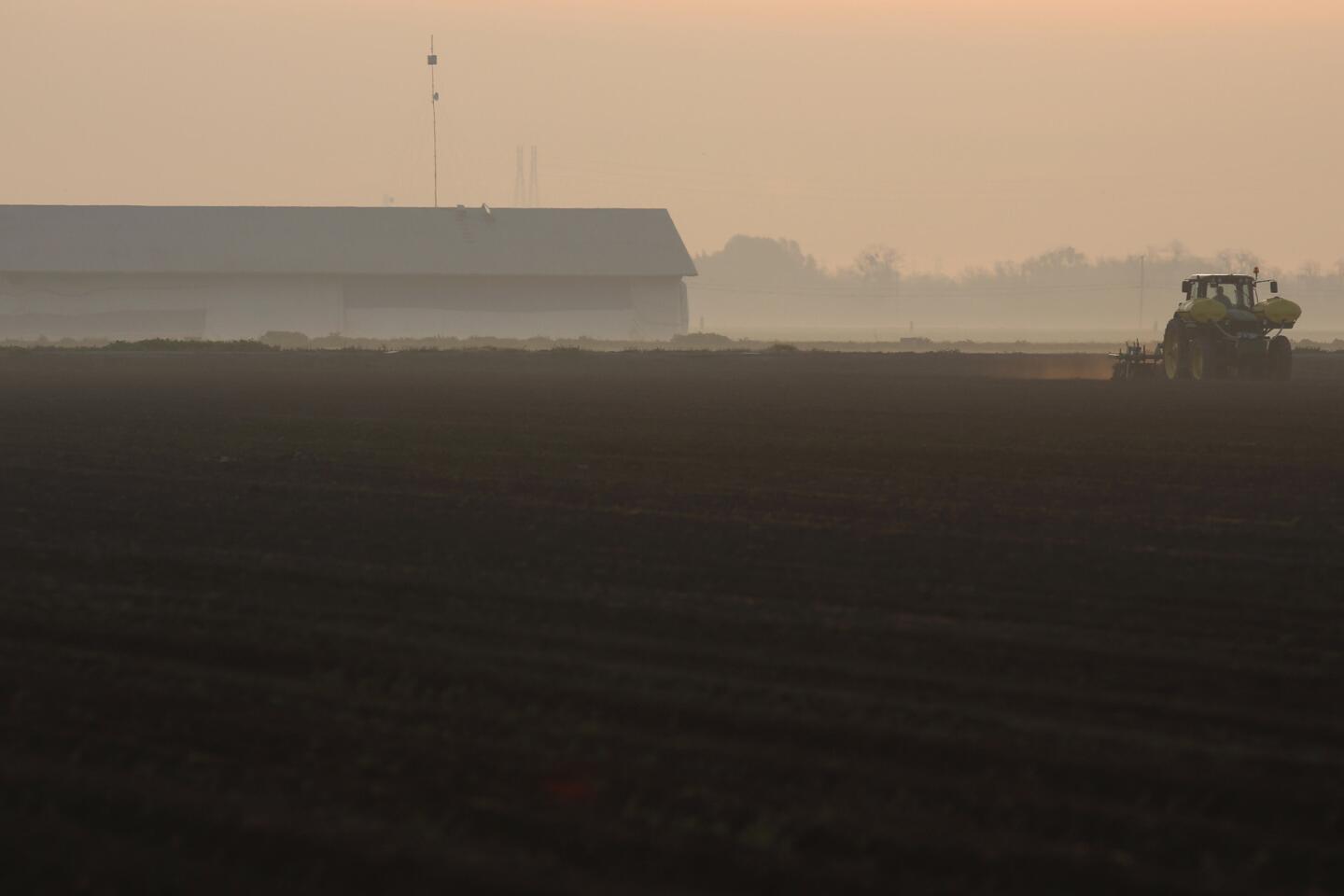A delta tunnel project’s lofty ambitions have been scaled back
- Share via
Reporting from BACON ISLAND, Calif. — A dog trotted down the middle of a levee road as red-winged blackbirds darted in and out of the reeds. A few fishermen dangled their baited lines into the muddy brown water.
Only a close look at the Middle River revealed anything amiss in this part of the Sacramento-San Joaquin Delta. Instead of flowing north toward San Francisco Bay, as nature intended, the Middle was headed south. On the other side of Bacon Island, the Old River was doing the same thing.
The backward flow of these two obscure channels is at the core of a proposal to build California’s biggest water project in decades: a $15-billion diversion and tunnel system in the delta, the ecologically failing hub of the state’s waterworks.
The long-planned project would draw directly from the Sacramento River as it enters the north delta and send water to enormous pumping plants that now pull supplies entirely from the south delta. The intensive pumping that now takes place causes the environmentally harmful reverse flows that have triggered increasingly tight limits on water deliveries to San Joaquin Valley growers and Southern California cities.
In news releases and tweets, tunnel backers have lamented the “lost” and “wasted” water from the Sacramento River that could have been pumped south during this year’s winter storms if only the delta had a “modern delivery system.” About 486,000 acre-feet — or enough water to serve 3.6 million people for a year — could have been captured, the project website proclaims in big, bold numbers.
But scroll down on the website, below those impressive figures, and you now find a cautionary note: “The project on average over time is not expected to provide a significant increase in water deliveries from the Delta.”
The language reflects a major scaling back of the project’s once lofty ambitions.
The San Joaquin Valley irrigation districts and Southland water agencies that would pay for the project originally envisioned it as a grand delta fix that would push water exports back to — or even above — their peak in the early 2000s of an average 5.3 million acre-feet a year.
But as the project has gone through a protracted environmental review by skeptical federal fishery agencies, reality has set in. Instead of cranking open the pumps, the tunnels will, at best, do little more than maintain the status quo.
“This idea that it’s all going to be resolved is fiction,” said state Department of Water Resources Director Mark Cowin, whose agency is overseeing the proposal along with the U.S. Bureau of Reclamation.
The tunnels would lessen the damaging reverse flows. But they would not cure the delta’s other ecological ailments, many of which stem from the exports and upstream diversions that have profoundly altered delta hydrology and robbed the ecosystem of about half its natural flow to the bay.
Nor would the project escape the regulations concerning endangered species and water quality that will probably grow tougher in response to the delta’s cascading environmental woes.
If the tunnels are built, state modeling indicates future delta exports to the valley’s thirsty fields and Southern California’s faucets would average 4.9 million acre-feet a year — only a small improvement over recent averages.
Without the project, however, Cowin warns that number could fall by 1 million acre-feet — to roughly 1970s levels.
Officially named the California WaterFix, the project has become less a fix than a multibillion-dollar tourniquet.
::
The Old and Middle rivers are in the south end of the delta. There, the state and federal pumping plants draw water to fill the highway-size California Aqueduct and the Delta-Mendota Canal that carry supplies south.
The harder the enormous pumps work, the stronger their wrong-way pull on south delta channels and native fish. Migrating chinook salmon and steelhead wander off course into the mouths of predators or to the dead-end of the pumps.
The finger-size delta smelt — declared a threatened species by the federal government — follow the unnatural flows away from good spawning habitat, edging ever closer to extinction.
Two in three fish drawn into the south delta by the pumping perish, according to government biologists.
Under WaterFix, the new water diversion point on the Sacramento River in the north delta would feed two massive 35-mile tunnels supplying the pumps. Thus, less water would be drawn directly from the south delta, reducing the problematic reverse flows.
It is a variation of an old idea. Decades before the Endangered Species Act was enacted, when delta smelt were so plentiful they were used as bait, water managers foresaw problems with using the delta as a water pipeline for the south.
By the 1960s, government planners were pushing plans for a peripheral canal to carry supplies from California’s biggest river, the Sacramento, around the delta to existing federal pumps and the soon-to-be built State Water Project pumping plant.
Among the benefits cited in a 1966 state document: Improvements in the quality of exported water and a halt to “damage to the delta fishery.”
But it was cheaper to use the delta. The canal wasn’t built. The proposal resurfaced again years later, only to be killed by voters in a 1982 statewide referendum that played on California’s perennial north-south water tensions.
This time, opposition is centered in the delta, where the landscape of levee-ringed farm islands and curling water channels hasn’t changed much in a century.
“Save the delta. Stop the tunnels,” signs are staked next to delta roads. Local growers don’t want a mammoth, years-long construction project mucking up islands in the eastern delta. And most of all, they don’t want the tunnels sucking up good-quality Sacramento River water before it gets to their irrigation ditches.
Environmentalists worry about salmon losses at the three big river intakes that would be built near Hood, Calif. And state assurances to the contrary, they are convinced the tunnels will inevitably be used to suck more water from the delta watershed.
::
The nerve center of the State Water Project and the federal Central Valley Project is housed in a nameless building in a Sacramento suburb, where managers in the Joint Operations Center monitor data around the clock and relay orders to the field offices that move water supplies around California.
Crucial to that movement are delta conditions, which are religiously measured, recorded and scrutinized.
How much water is being released from upstream reservoirs in the Sacramento and San Joaquin river watersheds? How much fresh water is flowing into the delta? How much is going out to San Francisco Bay? What are the salinity levels? How muddy is the water? How many protected fish have been collected at the pumps? How strong are the reverse flows in the Old and Middle rivers?
The reverse flow is measured in negative numbers on either side of Bacon Island and plays such a dominant role in exports that Cowin said he can recite it any minute of the day.
It is by no means, however, the only limit on delta pumping.
In the final months of last year and the early days of January the pumps were turned down to meet water quality and other state standards. If not enough fresh water flows out of the delta to the bay, salty water can intrude, tainting delta supplies.
Then it started raining and “we were meeting the outflow, no problem,” recalled state water operations chief John Leahigh. Exports bumped up, though they were still capped to protect out-migrating salmon.
By mid-January, storm runoff had driven up the turbidity levels that trigger delta smelt movement. Daily sampling surveys found some of the translucent little fish near the mouths of the Old and Middle.
To avoid drawing smelt to the pumps, the pumping rate limit was tightened and exports dipped. When smelt were caught at the pumps Jan. 21, the exports were further restricted, only to rise again when turbidity levels dropped during February’s dry spell.
On a late February afternoon, the drone of 100,000 horsepower of pumping muscle filled the federal C.W. “Bill” Jones Pumping Plant not far from the walled subdivisions of Tracy, Calif.
Four of the plant’s six pumps were discharging delta water into the head of the 117-mile-long Delta-Mendota Canal for a trip to the San Joaquin Valley.
At the nearby diversion point on the Old River, a network of screens guided fish into pipes that carried them to large collection tanks. There they were held until tank trucks transported them to the western delta for release.
As part of a routine check for protected species, a worker hoisted a cone-shaped bucket out of one of the holding tanks and emptied it into a rectangular sorting tray.
Biologist Rene Reyes dipped a net into the water, scooping up a baby catfish. Next came a couple of bluegills and six silversides. “All introduced species, very hardy,” he said.
No smelt. No salmon. It was a good day for water exports.
Twitter: @boxall
MORE FROM SCIENCE
UC Irvine’s leafy campus is now one big laboratory to fight tree-killing beetle
What does it mean to have a ‘good death’?
Fungus that has killed roughly 7 million bats has now reached the West Coast
